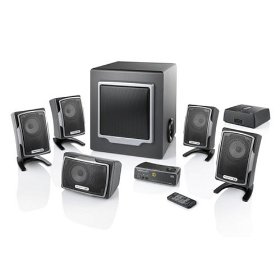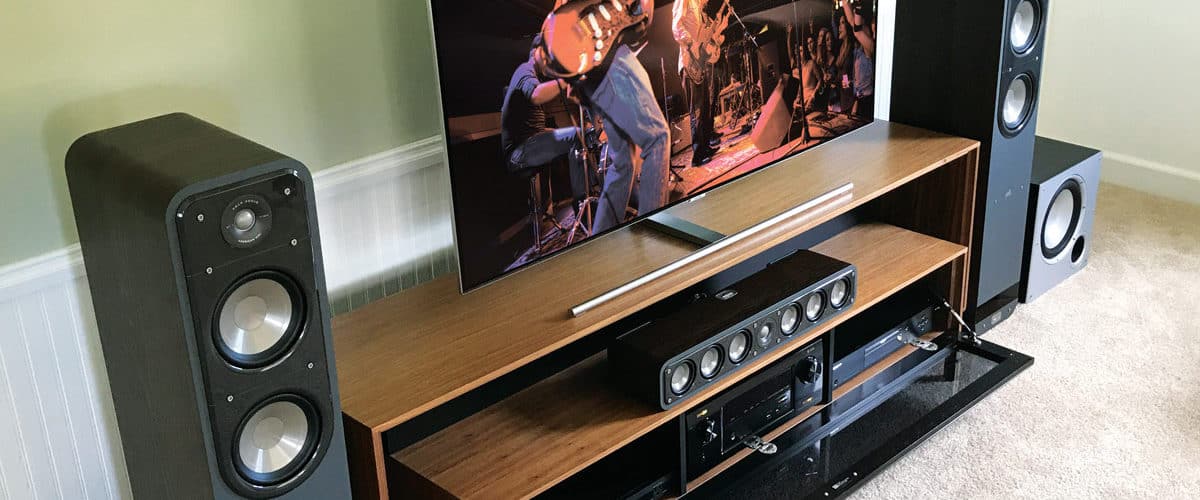
It seems that everything is going wireless today. Mobile phones are in millions of pockets. Wifi technology provides Internet service to people without a hook up. Therefore, it is only natural that home theatres would follow the same progression. The wireless surround sound system of today will sound just as good as the hardwired system, and it will work its magic without miles of speaker wire running in each and every direction.
Surround sound is the idea that speakers should surround those individuals who are listening to their output. An idea situation would be one in which all sides of the listeners are covered by speakers. This sort of saturation requires a newer method of sound processing, and home media is only now taking full advantage of processing protocol like the DTS ES or Dolby Digital Ex systems.
Therefore, it is much more common to see systems that are organized around protocols that incorporate, or are similar to, the DTS 5.1 or Dolby Digital 5.1 systems. These systems are older, but they are more widely supported. While the DTS ES or Dolby Digital Ex systems provide coverage from each side, these more established systems provide for two rear speakers. These two rear surrounds cover the left and right sides of the listener.
Methods like the DTS ES or Dolby Digital Ex systems require an input with 6.1 or 7.1 compatibility. Stereos will often drive a two-channel feed. Trying to find a healthy balance between the two is very important if one wants to listen to music and watch movies with their home entertainment system.
When working with these two-channel music sources, many individuals will opt for a set of standing tower speakers for the front sound system. However, this is often not an option when working with the smaller range of equipment available to those setting up a wireless sound system.
Nevertheless, there are some models of floor speakers available to those working with wireless systems. While one will probably not find something that is equivalent to the giant stand up models found at rock concerts, the market does have several serviceable versions available. These often run around $300, and come in various configurations.
Some audiophiles will argue in favor of setting up every speaker as a floor model. Along with the prerequisite subwoofers, this would certainly turn one’s home into a mosh pit environment. However, having ungainly speakers sitting in each direction takes away many of the advantages that wireless technology is supposed to provide. Therefore, small models are generally best for rear surrounds.
Smaller wireless speakers that are designed with MP3 players in mind can cost about $60. For much more professional models, one might expect to pay $100-$150 for these pieces of equipment. On the bright side, the digital processing technology that they employ can make the sound system that much more crisp and realistic.
A subwoofer handles the lowest of sound frequencies, and any serious surround system needs to have subwoofer technology integrated into it. If you’re using your system for music, capturing any sort of low tones will not sound complete without one. They are an even more important piece of equipment for those who use their systems for viewing motion pictures. Until recently, however, only conventional hardwired systems had access to quality subwoofers.
That has changed with the availability of several models in the $300 to $400 range. A subwoofer will really unleash the raw, unbridled power that one’s new wireless surround sound speaker system has lying within.
Radio technology is the basis behind the entire wireless aspect. Speaker wire usually handles the transmission of information from the sound input to the sound output. With wireless surround sound systems, radio waves are the medium of transportation for this data. While one should be careful to make sure nothing interferes with the transmission and reception of radio signals in a wireless network, the advent of commonly available microwave radio technology solutions has made much of these interference problems a thing of the past.
Granted, there is nothing wrong with opting for a small system. After all, such an elaborate set up will not work for everyone. Instead, there are small speakers available that offer at least somewhat similar performance. Some pairs of speakers are around seventy pounds in weight, and offer acceptable performance without the associated high prices of a more professional installation. $200 is a relatively low price to pay when considering the otherwise high cost of speakers under other conditions.
When purchasing equipment for a wireless surround set up, be sure that everything is compatible with the components that you are purchasing. A single piece that is not going to work with an existing sound system will ruin the entire set up. Also be sure that nothing obstructs any of the speakers, especially when using smaller models. The surround sound concept relies heavily on having an uninterrupted swath of sound from various directions.
Also, be prepared for some troubleshooting. With wireless technology, there is a small chance of interference from other appliances in the area. Make sure to locate your surround sound setup away from other wireless technology and ambient radiators, like household appliances, if there is any interference from them.
A surround sound system can be very rewarding, and the application of modern wireless technology only adds to the fun. A modern audiophile has a wealth of options to choose from. Therefore, one should carefully weigh all of these options before making any decision.



